 After our unforgettable trip to Luxor's East Bank the day before, we went to see the magnificent tombs of the famous kings and queens of Egpyt in the West Bank of Nile.
After our unforgettable trip to Luxor's East Bank the day before, we went to see the magnificent tombs of the famous kings and queens of Egpyt in the West Bank of Nile. One unforgettable trip after another. This Pinoy was truly in travel heaven!
Our Luxor site seeing itinerary the day before was packed so were exhausted by the time we got back to our accommodation for the next few days - a river cruise boat. We were so tired that we got a full night's sleep even with a jetlag.
However, our wake up call was a little early again. Not 3am but 5am this time. We had to squeeze in our breakfast because we were picked up by our bus by 6am to start our drive to the West Bank to visit the Valley of the Kings. Not a lot of houses on this side of the Nile and I do not know if that is by design.

When we got to the complex, we were ushered to a museum while our guide secured our group tickets. I found this map of the Valley of the Kings showing all the different tombs unearthed so far.
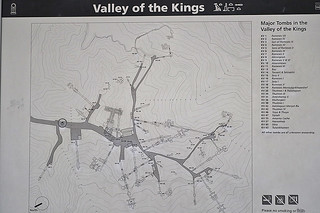
They also have this miniature version of the Valley and it is in 3D. I learned that the tombs are numbered by KV and a number - KV1 through KV62. KV as in Kings Valley. Excavations are on-going so I expect the number might go up as new tombs are discovered.
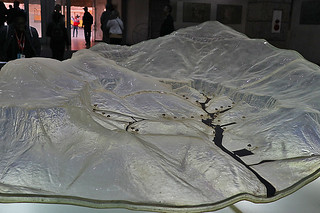
And that 3D includes the actual diggings of the tombs so I was able to see how deep the tombs are. This also prepared us that this site seeing will include walking down and then up.

After we got our tickets and, in my case, my photo ticket, we were asked to get on these shuttles that will take us to the area where the excavated tombs are. Even though we got there early in the morning, there were already lots of tourists on site.

The land is so dry. I do not know the last time this area has seen rain. My mouth actually felt dry the moment we got to the excavation sites. I cannot imagine what this place looks and feels like during warmer months.
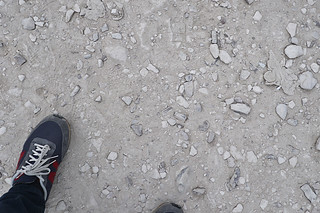
We all walked up to see the tombs up close. I noticed that some people were almost running. I was thinking to myself that these people might know something I don't?

Photography inside the tombs are not allowed. However, there is a ticket per photo equipment - be it a phone or a real camera. At the time, a photo ticket costs 300EGP. I figured this is what I came here for so Mijo and I decided we would only pay for one camera and it was going to be my camera. Photography is absolutely not allowed inside Tutankhamun's tomb even with a photo ticket.
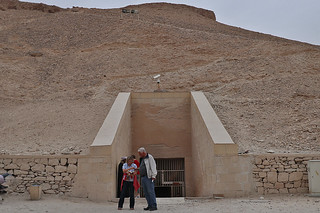
There are many tombs in the complex but we were only given three tickets plus we bought an extra ticket to see Tutankhamun's tomb. We also had an hour to be on our own. So that was 4 tombs in one hour including the walk between the tombs. There were times we were just in an out of a tomb - around 10 minutes.
We decided to see KV2 Rameses IV's tomb first. I learned that Rameses IV was a pharaoh of the 20th dynasty of the New Kingdom and his reign was only around six and half years.
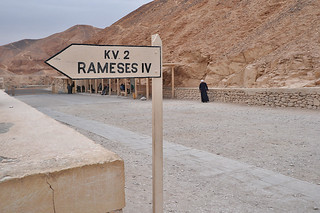
Since we arrived early enough, there was not a huge crowd trying to get in the tombs.
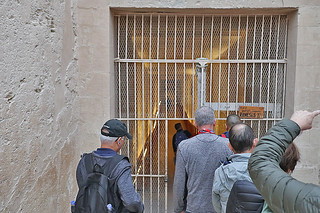
This was the first time I was seeing a tomb of a pharaoh. It was beautiful at the same time mystic. So I was walking really slowly and engrossing at the scene even though I do not understand any of the hieroglyphs etched on the wall.
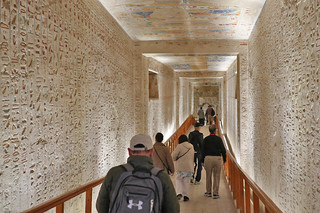
I learned that these hieroglyphs usually came from a book and serve as a guide for the dead in the afterlife such as the Book of the Dead and the Book of Caverns.

We finally reached the chamber where the sarcophagus was kept. The are scenes etched on the tomb.

More scenes taken from the books to serve as guide for the dead.

At this point, I was just taking pictures of everything without really understanding the meaning of the inscriptions.

I learned that the Goddess Nut was painted on the ceiling.
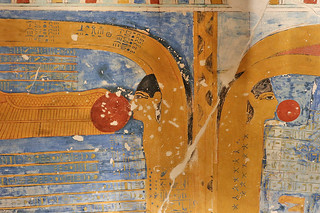
Looking at this, I couldn't help but notice how the ancient Egyptians prepared for the afterlife and the richer you are, the more luxurious the tombs got.
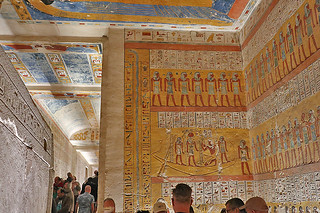
Here's a side view of the tomb.
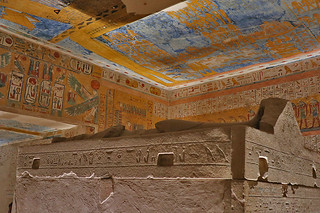
Mijo and I must have spent more than 15 minutes inside. That only meant that we had 45 minutes left to see the 3 other tombs.

KV62 is King Tutankhamun's tomb. Even with a camera ticket, taking pictures was not allowed inside King Tut's tomb. The tomb is not that big compared to the other tomb and it was designed like a letter J flipped horizontally. From the entrance, a corridor leads to the ante chamber and to its right is the burial chamber and the treasury. It was discovered by archeologist Howard Carter in 1922. The best part of this tour is King Tut's sarcophagus and mummy are displayed inside the burial chamber. Most of the items uncovered from the excavation are on display for conservation at the Egyptian Museum. We lingered the longest here. The left us with only less than 20 minutes to see two other tombs.
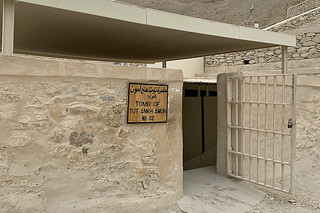
Our next tomb was KV6 or Rameses IX's tomb.
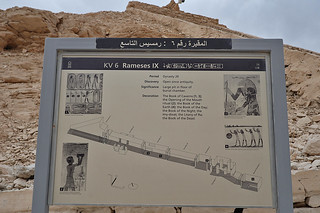
Since we were pressed with time, we were literally in and out of this tomb.

Just like the other tombs, this tomb has decorations with scenes from the Book of the Dead, Caverns and many others.

The layout is one long tomb with smaller chambers as we walked towards the burial chamber.
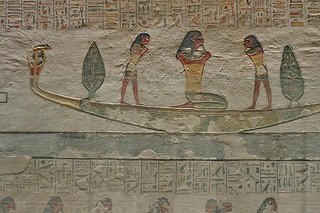
The corridor goes down these stairs.
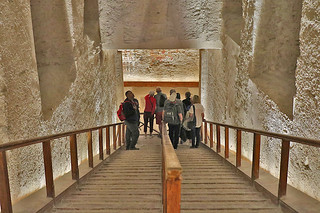
At the end of the stairs is the burial chamber.
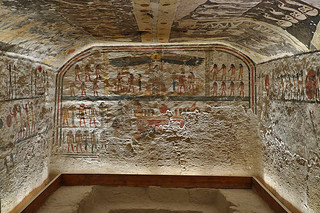
The next and last tomb we visited was KV14 or tombs of Tausert and Setnakht. We learned that Tausert was the Queen of Seti II and Setnakht was the successor of Seti II.
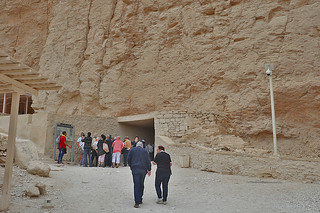
This tomb is located all the way at the end of the complex. This was recommended by our tour guide because of the colors that are still intact on the walls and the big burial chamber.

Everyone had the same idea because there was a line going in to the tomb.

Since we only had a little over ten minutes to see the tomb, we were literally in and out.
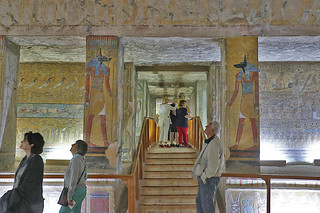
Nevertheless, I am still glad we went inside because it was all worth it.
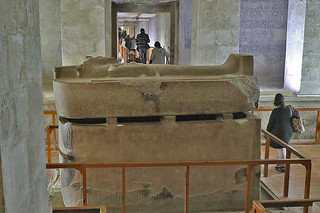
A short drive from the Valley of the Kings is a place called Deir Al Bahri. For me, the highlight of the tour of the West Bank of Luxor was this visit to Queen Hatshepsut's temple.
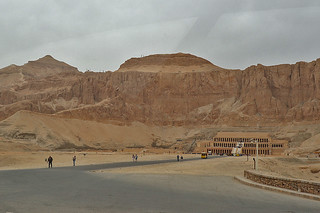
We hopped on the shuttle to get to the main temple complex. As a background, Queen Hatshepsut was the daughter of Thutmose I and wife to Thutmose II. She was the second female pharaoh. She reigned as a Pharaoh for 21 years from 1479 to 1458.
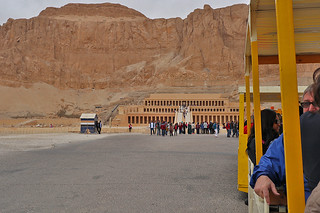
The mortuary temple is dedicated to Queen Hatshepsut and god Amun Re. It sits at the bottom of steep cliffs. The temple has three levels but only the upper two levels were open to the public when we visited. To give you a bird's eyeview, this is what the temple used to look like. I imagined it was complete with a lush garden and walls with gloriously colorful relief.
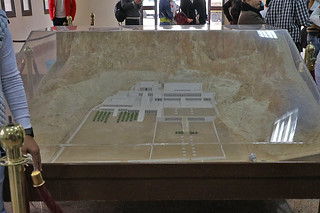
We went up the ramp from the first colonade and we got to the middle terrace which leads to the middle colonnade area.

Speaking of relief, here's a sample of a wall relief found in the temple's middle colonnade area. We learned that there are theories that the pharaohs who succeeded Hatshepsut, such as her stepson Thutmose III or his son Amenhotep II, might have had tried to erase her symbols from history judging by the cartouches and images of the queen that were chiseled off some stone walls.

Here the ramp to go to to the upper terrace where giant statues of Osirid stand next to the columns. The temple looks a little modern and kind of unique at that time with clean lines and symmetrical colonnaded terraces. The restoration of the area is ongoing.

Here's what it looks like looking out from the upper terrace.
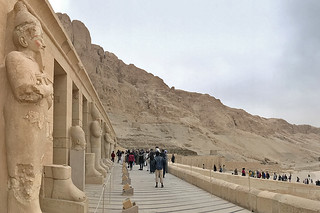
One of the statues of Osirid in the upper terrace.

We finally reached the Sanctuary of Amun.
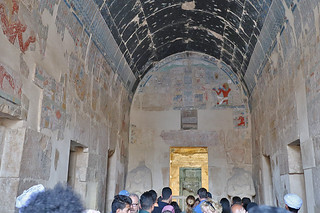
Here's what is left of the Chapel of Anubis on the right side of the temple. I was again in and out of this area because we were running out of time.

After that immensely enjoyable tour of Hatshepsut's temple, we were whisked by our tour bus to visit an labaster factory. We viewed a demonstration of grinding an alabaster the old fashion way. They also had an extensive collection of alabaster pieces for sale.
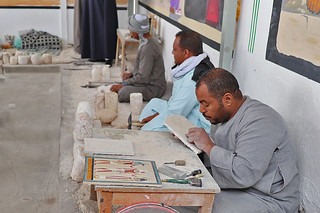


Afterwards, we stopped for a quick photo op at the Colossi of Memnon. We were told that these giant seated statues are of Amenhotep III.

I've learned in this trip to the West Bank of Luxor how truly important is to the ancient Egyptians. I finally connected the dots why the temples were built on the East bank of Luxor and the tombs on the west. Just like the sun setting on the west journeying through the dark and emerging victorious rising the next day, the soul of the great Egyptian rulers wanted to travel with the sun god in its journey to the afterlife.
~rl
No comments:
Post a Comment